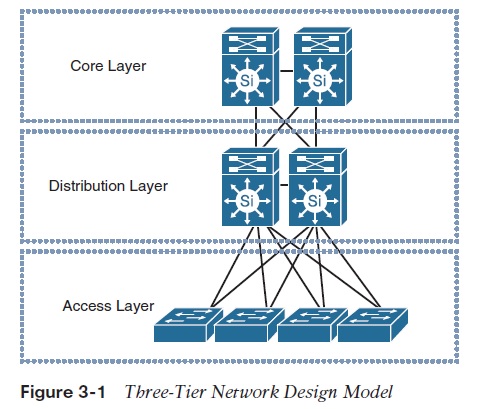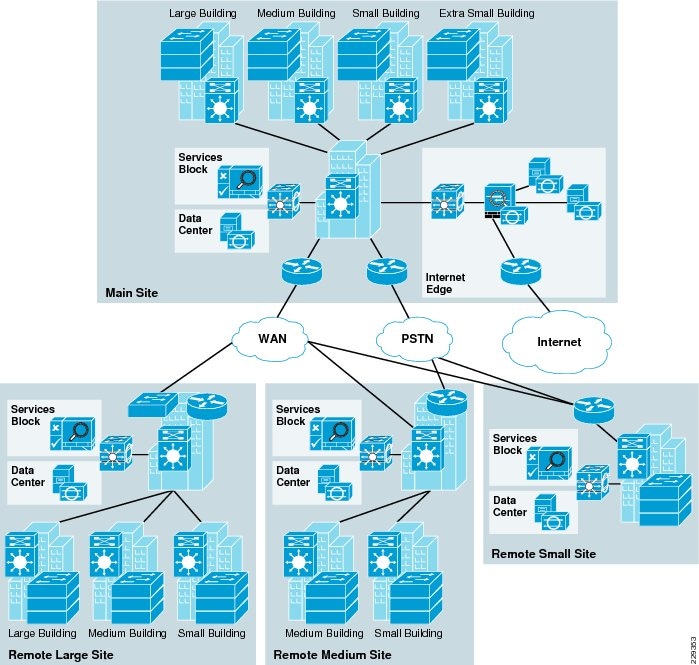Explain the Different Design Principles Used in an Enterprise Network
Explain the different design principles used in an enterprise network. Performed in a more controlled manner which can ultimately help network design-ers to view network design solutions from a business-driven approach.

Campus Network Design Models Network Computing
Regardless of network size or requirements a critical factor for the successful implementation of any network design is to follow good structured engineering principles.

. In contrast the bottom-up approach focuses on select-ing network technologies and design models first. 11 Explain the different design principles used in an enterprise network. This can impose a high potential for design failures because the network will not meet the business.
11 Explain the different design principles used in an enterprise network. Why are there different network architectures. Specify which IP address blocks will be assigned to different modules of your network design.
Three-tier model This design model illustrated in Figure 3-1 is typically used in large enterprise campus networks which are constructed of multiple functional distribution layer blocks. OSPF with multi-point interfaces converges slowly since you usually dont get a link down event. 11a Enterprise network design such as Tier 2 Tier 3 and Fabric Capacity planning.
Modularity Allows the network to grow on an on-demand basis Resiliency Satisfies user expectations for keeping network always on Flexibility Allows intelligent traffic load sharing by using all network resources These are not independent principles. Described below are three common types of enterprise networks. Document whether you will use manual or dynamic addressing for each module.
The steps required to design a good network are as follows. A hierarchical network model is a useful high-level tool for designing a reliable network infrastructure. 11a Enterprise network design such as Tier 2 Tier 3 and Fabric Capacity planning 11b High availability techniques such as redundancy FHRP and SSO 12 Analyze design principles of a WLAN deployment 12a Wireless deployment models centralized distributed controller-less controller based cloud remote branch.
Everything fails eventually even in networking. Information can be transmitted over different types of electrical cables. Architecture Explain the different design principles used in an enterprise network 11aEnterprise network design such as Tier 2 Tier 3 and Fabric Capacity planning 11bHigh availability techniques such as redundancy FHRP and SSO Analyze design principles of a.
A somewhat related principle. 12a Wireless deployment models centralized distributed controller-less controller based cloud. Analyze design principles of a WLAN deployment.
Computer networks are built to serve the needs of their clients. How to build a resilient network design. 12 Analyze design principles of a WLAN deployment 12a Wireless deployment models centralized distributed controller-less controller based cloud.
The most common ones are the twisted pairs that are used in the telephone network but also in enterprise networks and the coaxial cables that are still used in cable TV networks but are no longer used in enterprise networks. Dont use VLANs where you dont have to use dot1q routed interfaces instead. I have considered and applied the below design parameters in all my designs and would like to share it with the wider wireless community.
10 rows 11 Explain the different design principles used in an enterprise network. Up to 10 cash back 11a Enterprise network design such as Tier 2 Tier 3 and Fabric Capacity planning 11b High availability techniques such as redundancy FHRP and SSO 12 Analyze design principles of a WLAN deployment 12a Wireless deployment models centralized distributed controller-less controller based cloud remote branch. Enterprise network design such as Tier 2 Tier 3 and Fabric Capacity planning.
High availability techniques such as redundancy FHRP and SSO. 11a Enterprise network design such as Tier 2 Tier 3 and Fabric Capacity planning. The answer is yes.
The best approach to design the network topology is the structure approach which allows you to develop the optimal solution with lower cost with fulfilling all requirements of customer like capacity flexibility functionality performance scalability and availability. The two primary and common hierarchical design architectures of enterprise campus networks are the three-tier and two-tier layers models. Determine the features and functions required to meet the needs identified in Step 1.
11b High availability techniques such as redundancy FHRP and SSO. 11a Enterprise network design such as Tier 2 Tier 3 and Fabric Capacity planning 11b High availability techniques such as redundancy FHRP and SSO 12 Analyze design principles of a WLAN deployment 12a Wireless deployment models centralized distributed controller-less controller based cloud remote branch. Design and document an IP addressing scheme to meet ElectroMyCycles needs.
11b High availability techniques such as redundancy FHRP and SSO. Network pros have multiple factors to consider when it comes to adding redundancy in network design including network equipment protocols backup processing and subnet connections. Perform a network-readiness assessment.
Having understood the above requirements detailed planning following design principles best practices we can design a wireless network to cater for the current demand and future growth. Provide high availability through a resilient hierarchical network design Integrate IP communications mobility and advanced security Utilize multicast traffic and QoS to optimize network traffic Provide increased security and flexibility using access management VLANs and. These principles include Hierarchy.
Verify the business goals and technical requirements. Access networks for campuses and branches are built to bring users and things onboard such as connecting employees within an office building. 12 Analyze design principles of a WLAN deployment.
When using VLANs as patch cabling document it well both in a design overview document andor diagram and via descriptions such as the above. 7 factors to consider in network redundancy design. Document whether you will use public or private addressing for each module.
Create a solution and site acceptance test plan.

Medium Enterprise Design Profile Reference Guide Medium Enterprise Design Profile Medp Lan Design Design Zone For Security Cisco

Medium Enterprise Design Profile Reference Guide Medium Enterprise Design Profile Medp Lan Design Design Zone For Security Cisco

Network Design Models Do I Know This Already Quiz Cisco Press
Comments
Post a Comment